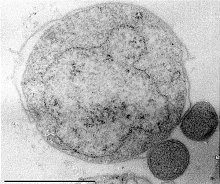
The eocyte hypothesis in evolutionary biology proposes that the eukaryotes originated from a group of prokaryotes called eocytes (later classified as Thermoproteota, a group of archaea).[1] After his team at the University of California, Los Angeles discovered eocytes in 1984,[2] James A. Lake formulated the hypothesis as "eocyte tree" that proposed eukaryotes as part of archaea. Lake hypothesised the tree of life as having only two primary branches: prokaryotes, which include Bacteria and Archaea, and karyotes, that comprise Eukaryotes and eocytes. Parts of this early hypothesis were revived in a newer two-domain system of biological classification which named the primary domains as Archaea and Bacteria.[3]
Lake's hypothesis was based on an analysis of the structural components of ribosomes. It was largely ignored, being overshadowed by the three-domain system which relied on more precise genetic analysis. In 1990, Carl Woese and his colleagues proposed that cellular life consists of three domains – Eucarya, Bacteria, and Archaea – based on the ribosomal RNA sequences. The three-domain concept was widely accepted in genetics, and became the presumptive classification system for high-level taxonomy, and was promulgated in many textbooks.[4][5]
Resurgence of archaea research after the 2000s, using advanced genetic techniques, and later discoveries of new groups of archaea revived the eocyte hypothesis; consequently, the two-domain system has found wider acceptance.[6][7]
- ^ Archibald JM (December 2008). "The eocyte hypothesis and the origin of eukaryotic cells". Proceedings of the National Academy of Sciences of the United States of America. 105 (51): 20049–20050. Bibcode:2008PNAS..10520049A. doi:10.1073/pnas.0811118106. PMC 2629348. PMID 19091952.
- ^ Lake JA, Henderson E, Oakes M, Clark MW (June 1984). "Eocytes: a new ribosome structure indicates a kingdom with a close relationship to eukaryotes". Proceedings of the National Academy of Sciences of the United States of America. 81 (12): 3786–3790. Bibcode:1984PNAS...81.3786L. doi:10.1073/pnas.81.12.3786. PMC 345305. PMID 6587394.
- ^ Zhou Z, Liu Y, Li M, Gu JD (April 2018). "Two or three domains: a new view of tree of life in the genomics era". Applied Microbiology and Biotechnology. 102 (7): 3049–3058. doi:10.1007/s00253-018-8831-x. PMID 29484479. S2CID 3541409.
- ^ Peirce SK (February 1999). "Three domains, not five kingdoms: A phylogenetic classification system". The American Biology Teacher. 61 (2): 132–136. doi:10.2307/4450634. ISSN 0002-7685. JSTOR 4450634. Archived from the original on 18 June 2024. Retrieved 16 May 2022.
- ^ Forterre, P. (2015). "The universal tree of life: An update". Frontiers in Microbiology. 6: 717. doi:10.3389/fmicb.2015.00717. PMC 4508532. PMID 26257711.
- ^ Nobs SJ, MacLeod FI, Wong HL, Burns BP (May 2022). "Eukarya the chimera: Eukaryotes, a secondary innovation of the two domains of life?". Trends in Microbiology. 30 (5): 421–431. doi:10.1016/j.tim.2021.11.003. PMID 34863611. S2CID 244823103.
- ^ Williams TA, Cox CJ, Foster PG, Szöllősi GJ, Embley TM (January 2020). "Phylogenomics provides robust support for a two-domains tree of life". Nature Ecology & Evolution. 4 (1): 138–147. doi:10.1038/s41559-019-1040-x. PMC 6942926. PMID 31819234.